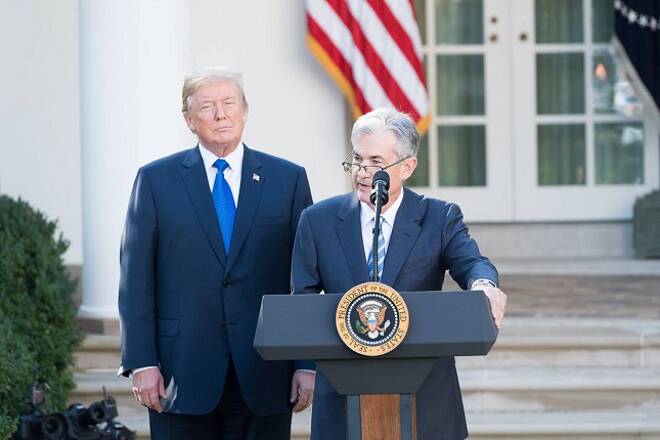Advertisement
Advertisement
EUR/USD Daily Technical Analysis for February 28, 2018
By:
The EUR/USD traded under pressure as the dollar gain traction during new Fed Chair Powell’s testimony in front of Congress. The markets looked at the way
The EUR/USD traded under pressure as the dollar gain traction during new Fed Chair Powell’s testimony in front of Congress. The markets looked at the way that Powell discussed a potential overheating economy which could potentially lead to 4-rate hikes in 2018.
Technicals
The EUR/USD moved lower pushing through trend line support at 1.2250, and poised to test the February lows at 1.2205. Resistance on the exchange rate is seen near the 10-day moving average at 1.2355. Momentum is negative as the MACD (moving average convergence divergence) histogram is printing in the red with a downward sloping trajectory which points to a lower exchange rate. The fast stochastic generated a crossover sell signal, but the current reading is below 20, which puts the stochastic in oversold territory.
ECB’s Weidmann flags possibility of 2019 rate hike
The Bundesbank President continues to talk hawkish at the presentation of the German central bank’s annual report saying he doesn’t see a reason to extend QE beyond this year, while highlighting sustainable upticks in inflation and for Germany the recent wage agreement from the IG Metall that came in on the high side. Weidmann also repeated that the ECB is keeping a close eye on exchange rate movements, but suggested a gradual reduction in stimulus, which could suggest he is backing an end to net asset purchases in several steps in Q4. Weidmann was also quoted as saying that a rate hike in 2019 is not totally unrealistic. A rate hike next year would not be inconsistent with the ECB’s current guidance, which suggests rate hikes may only come on the agenda until well after the end of net asset purchases, which we expect to end this year. That would allow a rate hike in the second half of 2019 in our scenario.
The Bundesbank President said at the presentation of the central bank’s annual report that growth in “Germany, the Eurozone and beyond” was very satisfactory and that the “recovery accelerated further in the second half of the year. He admitted that growth is not totally evenly balanced, but stressed that “in both the euro area and Germany, the economy is therefore growing at a faster pace than potential output, and this has already been the case for some time”. “What this also means is that the real economic situation and the monetary policy stance have rarely diverged as much as they do now”.
Eurozone ESI economic confidence fell back
Eurozone ESI economic confidence fell back to 114.1 in February, while the January number was revised up to 114.9 from 114.7 reported initially. Industrial confidence dropped back to 8.0 from 9.0, services confidence to 17.5 from 16.8, and consumer confidence was confirmed at 0.1, down from 1.4 in the previous month. This is the second consecutive decline in the headline reading, but at 114.1 the ESI remains far above the levels seen throughout last year and firmly above the long term average of 101.2. So like the other confidence reading this month, the ESI fell back, but remains at very high levels consistent with ongoing robust growth.
ECB’s Draghi dismisses notion of currency war
ECB’s Draghi dismisses notion of “currency” war, but highlights increasing volatility. Draghi told lawmakers that “there isn’t any currency war I would talk about”, but added that the governing council is worried about increasing volatility, which “might cause unwanted tightening” of financing conditions in the euro area.
German state inflation numbers weaker than expected
German state inflation numbers weaker than expected, with annual rates from Saxony, Brandenburg, Hesse, NRW and Bavaria dropping 0.1-0.2 percentage points. We had been expecting a steady annual rate for HICP and CPI, but the median consensus predicted a slight dip in HICP to 1.3% year over year from 1.4% year over year.
Eurozone M3 money supply growth held steady
Eurozone M3 money supply growth held steady at 4.6% year over year in January, as expected. Lending to households rose 2.9% year over year, lending to companies picked up 3.4% year over year. The headline M3 numbers have pretty much been demoted in the ECB’s monetary policy tool kit, but the fact that lending growth is looking solid now will back the arguments of the hawks, which argue that the Eurozone can live without further asset purchases, at least as long as rate hikes are not on the immediate agenda.
Spanish HICP inflation jumped to 1.2% year over year from 0.7 year over year in the previous month. At 1.2% year over year the annual rate remains far below the ECB’s target for price stability, but the sharp rebound still suggests that the recent set back in headline rates was temporary and that inflation is starting to nudge higher. Even the ECB now admits that underlying inflation indicators are starting to pick up and with labor markets continuing to improve wage growth is also expected to move higher.
About the Author
David Beckerauthor
David Becker focuses his attention on various consulting and portfolio management activities at Fortuity LLC, where he currently provides oversight for a multimillion-dollar portfolio consisting of commodities, debt, equities, real estate, and more.
Did you find this article useful?
Latest news and analysis
Advertisement
